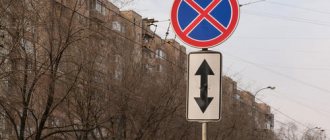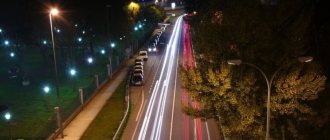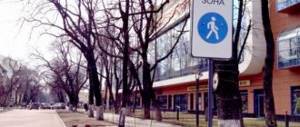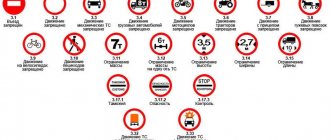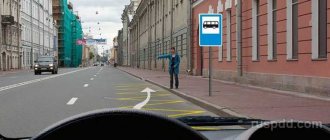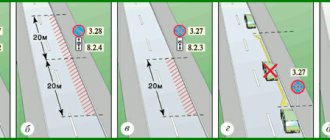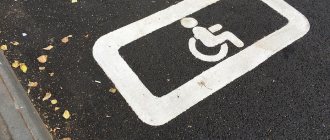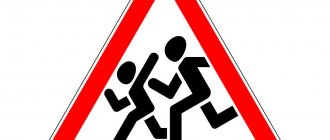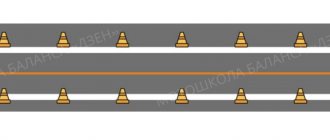- July 26, 2019
- Automobile law
- Oksana Sergeeva
Every driver sees every day a sign installed on city streets or country roads that does not give the right to stop. But not everyone, for various reasons, can accurately understand the purpose of this technical element of road traffic, especially if there is a sign with an arrow underneath it.
In order not to violate the requirements for prohibiting stopping, which are specified by additional information in the form of a sign with an arrow down, it is necessary to competently understand the Rules of the Road. This will allow you to avoid an unpleasant conversation with a traffic police inspector and paying a fine for violating the rules.
What does the term "Stop" mean?
According to the interpretation of traffic rules, a stop is an intentional cessation of movement for up to five minutes. The word “intentional” means that the maneuver is carried out at the request of the driver, and not as a result of traffic lights or traffic controller signals. The rules allow stopping for a longer period of time if it is associated with boarding or disembarking people from a vehicle, as well as for loading or unloading it. In this case, the duration of such a maneuver does not matter.
A prohibition on stopping may be indicated by appropriate road signs or specified in the Traffic Rules. Signs are installed in cases where the driver needs to be told that he should not stop on a certain section of the road. Moreover, on a neighboring street with the same parameters of the roadway, this ban may not exist. There are also places on the roads where the driver, even without signs, must clearly understand that stopping there is prohibited. For example, closer than 5 meters from a street intersection or pedestrian crossing. Or on narrow streets with continuous markings, where other motorists will have to go around a parked car into the oncoming lane.
Traffic obstruction
Often, parking in the wrong place interferes with traffic. And here the designation “Stopping is prohibited” (sign) begins its work. The fine for this violation increases several times. But not yet significant enough to panic.
According to the law, if you park or stop where you are not allowed, you will have to pay a fine of 2,000 rubles. The vehicle will also be towed to a special impound lot. From there it will need to be redeemed. The payment amount varies in different regions. Count on several thousand rubles.
General information about the “No Stopping” sign
The very name of the sign indicates that it belongs to the category of prohibitory road elements, with the help of which traffic restrictions are applied or lifted. Its number in State Standards is 3.27. If this sign is installed, stopping in its coverage area is not allowed. If in populated areas on the right side of the roadway in the direction of travel there are prohibitions on stopping cars, then the driver has the right to perform this maneuver on the left side. There are many cases of installing a “No Stopping” sign with an arrow.
“No Parking” sign - coverage area and responsibility
One of the most important ways to regulate traffic on the roads is road signs. These include the “No Parking” sign, which means that the vehicle should not be stopped during a certain section of the route. Parking under a prohibiting sign is also prohibited.
What does the traffic regulations say?
According to the traffic rules, paragraph 3.27, the sign “Parking is prohibited” is a circle filled with blue, with a rim and crossed out by two red lines at an angle of 90 degrees to each other.
It is interpreted as prohibiting any vehicle from parking in a particular area.
Exceptions include public transport, which is allowed to stop in the order of its route for passengers to enter or exit.
Specialized road markings can be used in conjunction with a special sign. For example, to indicate the area in which it operates, a yellow stripe is drawn on the road or curb (marking 1.4). It is also possible to install other marks indicating a certain type of transport that is prohibited or allowed to stop in the area of distribution of the designation.
Under the special road sign “Stopping is prohibited” there are sometimes signs described in paragraphs 8.4.1-8.4.8, 8.18, 8.2.3 and 8.2.4 of the traffic rules. They are discussed in more detail below.
General information about the “Area” sign
Signs that carry additional information, which for simplicity are called signs, clarify or limit the effect of the signs with which they are installed. The “Down Arrow” sign under the “No Stopping” sign indicates the limit of the imposed restriction. In relation to sign 3.27, this plate indicates the end of the prohibited stopping zone. The sign cannot be installed independently and is considered invalid if there is no main road sign on the post or support. The plate number in GOST is 8.2.3.
Penalty for violation
Failure to comply with the requirement to prohibit stopping is punishable by administrative fines for illegal parking (Administrative Offences, Article 12.19) and range from 500 to 3,000 rubles. Stopping on railway tracks can result in the deprivation of a driver’s license for up to six months (Administrative Code Art. 12.10).
A sign warning of a potential threat to the evacuation of a car (tow truck icon 8.24) is installed in the area of effect of the sign prohibiting stopping (Federal Law No. 143 2015/08/06).
So, a stop prohibition sign with an arrow down, which is a combination of two signs 3.27 and 8.2.3, indicates the end of the prohibitory sign that was installed earlier. The effect of the combined sign applies only to the side where it is located and does not entail an automatic transition to the opposite side of the roadway.
Goal: to cancel the ban on a possible (necessary) stopping of a vehicle earlier than is provided for by the road layout in a specific location. Stopping a car behind a sign is completely legal, but stopping in front of it is considered a parking violation and entails penalties, including the evacuation of an unattended car.
Dear readers, the information in the article may be out of date, take advantage of a free consultation by calling: Moscow +7
, St. Petersburg
+7 (812) 317-70-86
or via the feedback form below.
The coverage area of prohibition signs is clearly specified in the legislation. Moreover, not only in the traffic rules (although the main extents of the distribution of these signs, except for exceptions, are still spelled out in the Rules), but also in GOST. In particular, in the article we will find out what is the coverage area of the prohibitory sign 3.27 “Stopping is prohibited” for 2021, including when it is in effect with signs of the sign’s coverage area, and if this sign is temporary. We will also find out in which cases such action periods do not apply.
So, the coverage area of the signs is regulated by Appendix No. 1 of the Traffic Regulations and GOST R 52289-2004 “Rules for the use of road signs.” According to these legal acts, the area of effect of prohibitory signs can be limited either by the nearest intersection, the end or beginning of a populated area, a corresponding sign installed along with such a sign and indicating with upward arrows the extent of its action, or a sign of the cancellation of the corresponding ban introduced earlier by the sign.
But there are certain subtleties in the use and, most importantly, reading of such signs, as well as exceptions to the general rules.
How to perceive the “No Stopping” sign with a sign and separately
A sign installed without an additional plate has the following coverage area:
- From the immediate installation site to the first intersection, and if there is no intersection in populated areas, to the end of the given populated area.
- Until sign 3.31, which removes all previously introduced restrictions.
- Until the repeated “No Stopping” sign with an arrow. Next, the prohibition zone will be determined using an installed sign.
The effect of the “No Stopping” sign, under which one of the “Area of Action” signs is attached, is determined by the value of the corresponding element of additional information. The "Down Arrow" sign under the "No Stopping" sign means that the restrictions for stopping have been lifted. Parking with such an addition in front of the main prohibiting element is legally impossible. Thus, behind the “No Stopping” sign with an arrow down, there is no prohibition for stopping cars. If necessary, drivers can stop immediately behind the traffic prohibition symbol on the shoulder with sufficient width. If there is no shoulder, the car can be turned off at the edge of the roadway.
It is curious that the effect of some prohibitory signs is terminated in a simpler way. For example, the introduced speed limit is removed by installing a sign with the same image, but only without a red border along the contour, and the speed value itself is crossed out by several black lines. In relation to the “No Stopping” sign, this method is not suitable, because the lines that lift the ban may close one of the lines that introduced the ban.
Standards for installing signs on roads
For a No Stopping sign with a downward arrow, standard installation rules apply. One of the main requirements is that the installation of a road sign must be justified. In addition, the driver must have an unobstructed view of the sign from a distance of at least 100 m, so visibility obstructions such as bushes or billboards should not be a problem in understanding the restriction. From the roadway to the nearest edge of the installed sign, the distance is taken to be in the range of 0.5–2.0 m. The average height of fastening road signs when they are located on the side of the road is 2.0–3.0 m, and when installed above the roadway 5, 0–6.0 m. The “No Stopping” sign with a down arrow must be separated from the sign by a distance of 5 to 20 cm. Overlapping symbols is not allowed. In case of damage to signs 3.27 or 8.2.3, in which their perception becomes impossible, as well as in the loss of any of the signs, their replacement or restoration must be made within three days from the moment of discovery.
Using signs together with markings
Applying horizontal road markings to the surface allows drivers to feel more confident on the road and to navigate more freely in difficult situations, for example, when making a turn at an intersection of multi-lane roads. The same can be said about the markings prohibiting the stopping of vehicles. A continuous yellow marking placed on the edge of the roadway indicates the length of the section where a ban on stopping cars has been introduced. The end of the “No Stopping” sign with a down arrow corresponds to the end of the yellow marking line. In case of damage to a road element or its loss, the markings will tell motorists the area where they should not stop.
Penalties
Sometimes violations of the rules still occur, because not all drivers simply understand the prohibition of stopping. That is why penalties were introduced for traffic violations. This helps reduce the level of violations and minimize inconvenience for road users, including pedestrians.
In most cases, a standard fine of 500 rubles is imposed on the offender, but the legislation of the Russian Federation provides for a number of clarifications:
- If you stop under a sign in a parking space for people with disabilities, the payment amount increases to 5,000 rubles.
- If the stop provoked a dangerous situation on the road, and the car became an obstacle for other road users, then the driver will have to pay 2,000 rubles.
- Provided that the stop under the sign occurred in a city that has federal significance, the payment amount will vary from 2,500 to 3,000 rubles. In this case, it is possible that the vehicle will be detained.
It is worth considering that in addition to the fine itself, the driver will have to pay an amount for the services of a tow truck and the purchase of the car from the impound lot.
There are also certain places where a warning sign is not installed, but parking there is prohibited by traffic regulations:
- roads that are too narrow, stopping on which may interfere with the passage of a car;
- intersections and crossings for pedestrians;
- tram and railway tracks;
- tunnels.
It is also worth noting that in some cases the inspector can get by with a warning and not issue a fine, for example, when a stop was made to disembark a passenger or unload/load a car.
Thus, stopping and parking under a “No Stopping” sign with an arrow is prohibited, regardless of the amount of time spent on it. An exception can be made only for certain categories of motorists.
Subscribe to our feeds on social networks such as Facebook, Vkontakte, Instagram, Pinterest, Yandex Zen, Twitter and Telegram: all the most interesting automotive events collected in one place.
Places for installing the “No Stopping” sign
The need to prohibit stopping vehicles with the installation of signs 3.27 is due to many reasons. Here are some of them:
- To prevent traffic jams. If, during high traffic volumes, one of the traffic lanes is occupied by parked cars for a long time, this can lead to the creation of congestion on city streets.
- To prohibit cars from stopping near government agencies, schools, stadiums, concert halls, etc., as well as high-risk objects.
- To ensure road safety - in areas with limited visibility, when a stationary car can provoke a traffic accident.
Road signs “No stopping” with an arrow down in the indicated cases are installed if necessary, if the ban on stopping needs to be lifted, for example, not at the nearest intersection, but earlier, in a certain place, after which the effect of the main prohibited element loses its force.
Difference between the functions of signs prohibiting stopping and parking
A sign that prevents parking can be considered more “peaceful” than one that prohibits stopping. Even in his image there are not two red lines in the shape of a cross, but only one. The sign prohibits parking of vehicles, but allows stopping for up to five minutes or longer for boarding or disembarking passengers and loading and unloading operations. The situation is a little confusing, since it is difficult to imagine that someone will carefully look at the clock and estimate when the car stop will smoothly turn into parking. However, the inspector of the road patrol service may be interested in any car parked in the wrong place, and he will definitely check the time during which the driver parked where it is prohibited. The place where the parking ban is introduced is indicated by sign 3.28. A “No Parking” sign with an arrow pointing downwards shows where the prohibition ends. Parking is permitted immediately behind it.
Some terminology
Where to start? For example, you can and even need to clearly understand what the concept of stopping means in traffic rules. There are two terms. The first is a stop, the second is a parking lot. They play an important role in traffic rules.
If the driver intentionally stops his vehicle for a period of less than 5 minutes for the purpose of disembarking (or boarding) passengers, as well as for loading something into the car, this is considered a stop. Sometimes you can stay longer than the specified period. But only in rare exceptions, when the situation really requires it.
But intentionally stopping a car or any other vehicle for more than 5 minutes without the purpose of working with passengers or cargo is called parking. It is easy to get confused in these concepts. But you will have to feel the difference. After all, a sign prohibiting stopping is different from a parking ban. What exactly?
Application of temporary signs
Situations often occur on the road when on a certain section of the road it is necessary to make changes to the organization of traffic for a certain period. This is usually due to repair work on the road, resulting in a narrowing of the roadway. Naturally, if stopping cars was previously allowed in this place, now it will not be possible during the repair period, which is predetermined by the installation of a “Stopping Prohibited” sign. There were cases when drivers, accustomed to driving the same route every day, did not at first notice that changes had been made to the usual driving mode. In order to quickly reorient traffic participants to the new rules and ensure maximum safe driving during repair work, all temporary road signs installed in the work area have a yellow background. At the place where the work is completed, it is possible to install a temporary “No Stopping” sign with an arrow. The effect of the sign will be the same as that of a permanent sign. If the development area allows, drivers will be offered other nearby places to stop.
Administrative liability for violation of sign requirements
When a driver who has not practiced theoretical driving skills for a long time sees a “No Stopping” sign and a downward pointing arrow sign, he may misinterpret the directions of the prohibition. Indeed, the direction of the arrow “somewhere down” is somewhat confusing, making you think about the correct choice of answer. If you fail to make the right decision, there is a high probability of committing a violation. And, unfortunately, there are a sufficient number of so-called drivers for whom most of the installed road signs are not a decree at all. Such people are accustomed to stopping not where it is allowed, but where they want. Naturally, there can be no talk of any compliance with road traffic requirements. What penalties are provided for violations of the stop ban?
- A warning if this violation was committed by the driver for the first time. True, one cannot do without a subjective factor: not every traffic police inspector will agree to limit himself to an explanatory conversation.
- A fine of 500 rubles. But its size can reach up to 3000 rubles. What matters here are the consequences that the driver’s actions caused in relation to other road users, as well as the place in which the violation of the law occurred (in Moscow and St. Petersburg the fine is higher than in other regions).
- In extreme cases, the car may be forcibly towed to a parking lot, and such a procedure (the work of the tow truck, the time spent in the parking lot) will have to be paid additionally.
Every driver must remember how the “No Stopping” traffic sign with an arrow down works, so as not to accidentally end up in a violation zone. However, unexpected situations often occur on the roads. After all, a car is just a piece of equipment that can break down unexpectedly. If the breakdown turns out to be serious, associated with a malfunction of the steering or braking system, then the driver will no longer have a choice where to stop. Such a violation will be involuntary, but necessary. If such problems are confirmed, no fine will be imposed. The most important thing that is required of the driver is to park the car in such a way as not to create an emergency situation.
Meaning of a sign with a downward arrow under a no-parking sign
The roads in cities are always full of life, so it is always necessary to regulate traffic. To avoid unpleasant consequences. To do this, people came up with traffic rules that must be followed by all road users.
These rules also include driving correctly according to traffic signs. However, not all of them indicate how vehicles should move.
Sometimes there is a need to stop driving, but you must remember that you can’t stop on all sections of the road.
In Russia, there are quite enough specially designated parking spaces on all roads, and the driver must stop there. However, sometimes in life there are situations when you need to stop urgently and there is no time to go to the parking lot, besides, not all drivers know where they are, so many have to waste time searching for them.
If a stop needs to be made urgently , drivers often stop on the side of the road, at the edge of the road. However, there is a sign that prohibits all stopping on a certain specific section of the road.
This sign is “no stopping”, it is familiar to every driver. A round blue prohibitory sign crossed out with a red cross; such signs are not so rare on the roads. It is worth noting that this sign prohibits not only stopping on the indicated section of the road, but also leaving your car on it, that is, parking it.
It is worth clarifying that a stop usually lasts less than 5 minutes and is associated, for example, with loading passengers, while parking lasts more than 5 minutes . Both parking and stopping are always pre-planned by the driver and do not happen by chance.
It is very important to determine on which section of the road the sign prohibiting stopping begins and ends, because it depends on whether the driver will violate the traffic rules. The action of a sign always begins from the moment on which it stands. And in order to understand how long the action lasts, another sign is attached to the “no parking” sign.
The “no stopping” sign and the sign attached below with an arrow pointing down indicate that further along the road the sign’s instructions are no longer valid and the prohibition ends there. That is, it is forbidden to stop from the place where the sign is and back along the road, in other words, in the opposite direction.
It is worth noting that the traffic ban can be suspended by another sign. This is a blue square with the letter P. This sign indicates that you cannot stop on this particular section of the road. Typically, such a sign is installed with an additional sign that indicates the length of the parking lot.
It is very important that the prohibitory sign is only effective on the side on which it is installed. This fact is very important for city drivers. The fact is that very often in the town you cannot park on the right side, but if you follow some rules, you can move to the opposite side and park on it.
Often, if you can’t dwell on the right situation, then you can on the left. In addition, it is always worth remembering that this sign does not affect the movement of route passenger transport.
Violating the instructions of the “no stopping” sign is definitely not worth it, just like any traffic rules. In addition, this action will have a significant impact on the driver’s wallet, because the fine for such a violation is stipulated in the amount of one and a half thousand rubles, and people living in cities of federal significance are even less fortunate, because a violation faces a fine of three thousand rubles.
In addition, the traffic police inspector has the opportunity to detain your vehicle and place it in a impound lot. For this you will have to pay some more money to pick up the car, and it will ruin the whole day, because you will be left completely without a means of transportation.
Read also: BMW R 35 motorcycle
So, if you see a “no parking” sign with an arrow down, then parking on this part of the road and down it is prohibited, that is, the sign is valid from the sign where it was installed and on the section before it. Even if you really want to stop in the area covered by a prohibitory sign or there is a need for it, you should not do this, because this violation will seriously affect your wallet.
In addition, you may lose your vehicle . Look for another way out, for example, it is often possible to park on the other side of the road.
In addition, if you are standing under a “no parking” sign with an arrow pointing down, then after passing this sign, you will no longer be in its coverage area and will be able to calmly stop. After all, it is better to drive a few meters than to pay a large fine.
The coverage area of prohibition signs is clearly specified in the legislation. Moreover, not only in the traffic rules (although the main extents of the distribution of these signs, except for exceptions, are still spelled out in the Rules), but also in GOST. In particular, in the article we will find out what is the coverage area of the prohibitory sign 3.27 “Stopping is prohibited” for 2021, including when it is in effect with signs of the sign’s coverage area, and if this sign is temporary. We will also find out in which cases such action periods do not apply.
So, the coverage area of the signs is regulated by Appendix No. 1 of the Traffic Regulations and GOST R 52289-2004 “Rules for the use of road signs.” According to these legal acts, the area of effect of prohibitory signs can be limited either by the nearest intersection, the end or beginning of a populated area, a corresponding sign installed along with such a sign and indicating with upward arrows the extent of its action, or a sign of the cancellation of the corresponding ban introduced earlier by the sign.
But there are certain subtleties in the use and, most importantly, reading of such signs, as well as exceptions to the general rules.
What are the dangers of ignoring signs?
All elements of the path’s environment exist to be guided by and observed. Otherwise, this can lead to unpleasant and even tragic consequences. The easiest thing to do in such a situation is to get appropriate feedback from drivers who find it difficult to drive around a car parked in the wrong place. But an accident can also happen if you stop for a long time in a dangerous place. Therefore, the best advice to the driver is to always be disciplined on the road, show mutual politeness and, unless absolutely necessary, not stop in prohibited places, even if such a stop is regulated for some time by the current Rules.
Minor punishment
We figured out the rules a little. Well, what can we say about the violation of signs? What awaits the violating driver for stopping in the wrong place? It's quite difficult to answer exactly. After all, many factors are taken into account.
The smallest punishment you will face is a verbal warning and payment of a small fine. At the moment it is about 500 rubles. Occasionally, the driver may simply be warned about the violation and asked to correct the situation. But such cases rarely occur. More often than not, you have to deal with more serious situations.
Some final tips
The “No Stopping” sign with a downward arrow can be considered unusual to some extent. If the effect of prohibitory signs begins immediately from the place where they are installed, then in this case the opposite picture is obtained. The “coup” is indicated by a sign installed under the sign. It turns out to be a paradox: if the sign under the “No Stopping” sign with an arrow disappears for some unknown reason, its action immediately changes direction by 180 degrees. So it wouldn’t hurt a driver who is going to be held administratively liable by a traffic police inspector for failure to comply with the requirements of a road sign, it wouldn’t hurt to check whether the sign should be hanging on the stand: with or without a plate. The most correct solution to the situation would be to request the road organization involved in servicing this section of the road or street to provide a copy of the current traffic management project. This document, agreed upon with the traffic police, indicates the correct location of all road signs on a highway or city street, the presence of additional information signs under them and other useful information. In many cases, such schemes have assisted drivers in asserting their rights in court.
The Ministry of Transport and the State Traffic Safety Inspectorate of the Russian Federation are taking systematic measures aimed at improving road safety. The number of road signs is increasing, mainly due to the introduction of new ones and the restoration of those signs that, for a number of reasons, have been lost for a long time. In such a situation, the driver simply needs to monitor all changes from time to time and never forget about the purpose of the prohibitory symbol: the “Stopping is prohibited” road sign with an arrow down means that the prohibition ends right here, at the location of the combination of two signs.
